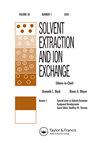用取代冠醚在新型氟化稀释剂中萃取铯、锶和稳定的模拟高分子量组分
IF 2.1
4区 化学
Q3 CHEMISTRY, MULTIDISCIPLINARY
引用次数: 7
摘要
研究了冠醚衍生物在新型氟化稀释剂中从硝酸介质中提取铯、锶和模拟高放废液中的一些稳定组分。根据萃取剂在水相中的溶解度和所使用的稀释剂的理化性质,选择了最有前途的萃取体系:4,4 '(5 ')-二叔丁基二苯并-18-冠-6 (L1)和4,4 '(5 ')-二叔丁基双环己基-18-冠-6 (L2)在二(2,2,3,3-四氟丙基)碳酸酯(BK-1)和二(2,2,3,3-四氟丙基)甲烷(FN-1)中的冠醚。对于这些体系,研究了一些稳定组分的提取及其随后的水和螯合剂溶液的溶出。铅被最大程度地共萃取。在较小程度上,钡和钙阳离子与锶共萃取,铷和钾阳离子与铯共萃取。铅、钡和银是最难剥离的;然而,铅剥离的问题可以通过使用DTPA或柠檬酸溶液与氨中和到弱碱性(pH 8)介质来解决。本文章由计算机程序翻译,如有差异,请以英文原文为准。
Extraction of Cesium, Strontium, and Stable Simulated HLW Components with Substituted Crown Ethers in New Fluorinated Diluents
ABSTRACT The extraction of cesium, strontium, and a number of stable components of simulated high-level waste solutions from nitric acid media with solutions of crown ether derivatives in new fluorinated diluents was studied. Based on the data on the solubility of the extractants into the aqueous phase and the physicochemical properties of the diluents used, the most promising extraction systems were chosen: crown ethers 4,4‘(5’)-di-tert-butyldibenzo-18-crown-6 (L1) and 4,4‘(5’)-di-tert-butyldicyclohexyl-18-crown-6 (L2) in bis(2,2,3,3-tetrafluoropropyl) carbonate (BK-1) and bis(2,2,3,3-tetrafluoropropoxy)methane (FN-1). For these systems, the extraction of a number of stable components and their subsequent stripping with water and solutions of chelating agents were studied. Lead was found to be co-extracted to the greatest extent. To a lesser extent, barium and calcium cations are co-extracted with strontium, and rubidium and potassium cations with cesium. Lead, barium, and silver are the most difficult to strip; however, the problem of lead stripping can be solved by using DTPA or citric acid solutions neutralized with ammonia to weakly alkaline (pH 8) media.
求助全文
通过发布文献求助,成功后即可免费获取论文全文。
去求助
来源期刊
CiteScore
4.40
自引率
5.00%
发文量
15
审稿时长
8.4 months
期刊介绍:
Solvent Extraction and Ion Exchange is an international journal that publishes original research papers, reviews, and notes that address all aspects of solvent extraction, ion exchange, and closely related methods involving, for example, liquid membranes, extraction chromatography, supercritical fluids, ionic liquids, microfluidics, and adsorption. We welcome submissions that look at: The underlying principles in solvent extraction and ion exchange; Solvent extraction and ion exchange process development; New materials or reagents, their syntheses and properties; Computational methods of molecular design and simulation; Advances in equipment, fluid dynamics, and engineering; Interfacial phenomena, kinetics, and coalescence; Spectroscopic and diffraction analysis of structure and dynamics; Host-guest chemistry, ion receptors, and molecular recognition.

 求助内容:
求助内容: 应助结果提醒方式:
应助结果提醒方式:


